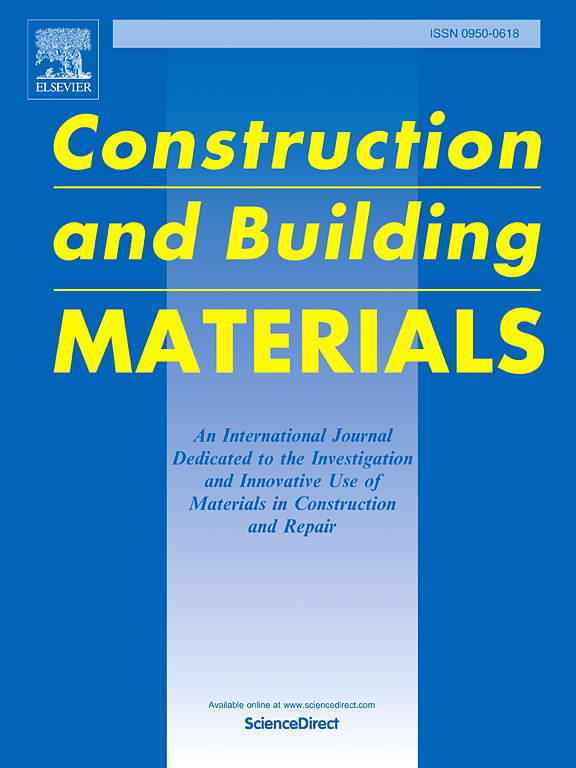Prediction of moisture content ratio of emulsified asphalt chip seal based on machine learning and electrical parameters
IF 7.4
1区 工程技术
Q1 CONSTRUCTION & BUILDING TECHNOLOGY
引用次数: 0
Abstract
The moisture content ratio (MCR) of the emulsified asphalt chip seal can determine its curing degree. However, the MCR of emulsified asphalt chip seal is difficult to measure on actual projects, and there is a lack of a method to assess its MCR. The objective of this study is to establish a prediction methodology for the MCR of emulsified asphalt chip seal based on machine learning and electrical parameters. Features such as electrical parameters and MCR of emulsified asphalt chip seal at different times were measured experimentally. The importance of the features was evaluated using a Random Forest (RF) model. A Back Propagation Neural Network (BPNN) prediction model was established using the important features. The weights and biases of the BPNN were optimized and initialized using the Improved Particle Swarm Optimization (IMPSO) algorithm. As a result, the RF-IMPSO-BPNN emulsified asphalt chip seal MCR prediction model was developed. This model was compared with five other models. The results show that compared to the RF-PSO-BPNN model, the improved RF-IMPSO-BPNN model can improve the ability of the neural network to find the global optimal solution. Compared to the other four machine learning models, the RF-IMPSO-BPNN model can achieve higher prediction accuracy while reducing the human and material resources of the various devices to collect part of the data. In addition, the emulsified asphalt chip seal cures at low MCR. The model predictions are more accurate at low MCR. Therefore, this study developed the RF-IMPSO-BPNN emulsified asphalt chip seal MCR prediction model, which can use fewer features to achieve higher accuracy and provide a rapid and non-destructive idea for judging its curing.
基于机器学习和电气参数的乳化沥青碎屑封层含水率预测
乳化沥青碎石封层的含水率(MCR)可以确定其固化程度。然而,乳化沥青碎屑封层的含水率很难在实际工程中测量,也缺乏评估其含水率的方法。本研究的目的是基于机器学习和电气参数建立乳化沥青碎屑封层 MCR 的预测方法。实验测量了不同时间乳化沥青屑封层的电参数和 MCR 等特征。使用随机森林(RF)模型对特征的重要性进行了评估。利用重要特征建立了反向传播神经网络(BPNN)预测模型。使用改进型粒子群优化(IMPSO)算法对 BPNN 的权重和偏置进行了优化和初始化。结果,开发出了 RF-IMPSO-BPNN 乳化沥青碎屑封层 MCR 预测模型。该模型与其他五个模型进行了比较。结果表明,与 RF-PSO-BPNN 模型相比,改进后的 RF-IMPSO-BPNN 模型可以提高神经网络寻找全局最优解的能力。与其他四种机器学习模型相比,RF-IMPSO-BPNN 模型可以达到更高的预测精度,同时减少了各种设备收集部分数据的人力物力。此外,乳化沥青碎屑封层在低 MCR 条件下固化。在低 MCR 条件下,模型预测的准确性更高。因此,本研究开发了 RF-IMPSO-BPNN 乳化沥青碎屑封层 MCR 预测模型,该模型可以使用较少的特征来达到较高的精度,并为判断其固化情况提供了一种快速、无损的思路。
本文章由计算机程序翻译,如有差异,请以英文原文为准。
求助全文
约1分钟内获得全文
求助全文
来源期刊

Construction and Building Materials
工程技术-材料科学:综合
CiteScore
13.80
自引率
21.60%
发文量
3632
审稿时长
82 days
期刊介绍:
Construction and Building Materials offers an international platform for sharing innovative and original research and development in the realm of construction and building materials, along with their practical applications in new projects and repair practices. The journal publishes a diverse array of pioneering research and application papers, detailing laboratory investigations and, to a limited extent, numerical analyses or reports on full-scale projects. Multi-part papers are discouraged.
Additionally, Construction and Building Materials features comprehensive case studies and insightful review articles that contribute to new insights in the field. Our focus is on papers related to construction materials, excluding those on structural engineering, geotechnics, and unbound highway layers. Covered materials and technologies encompass cement, concrete reinforcement, bricks and mortars, additives, corrosion technology, ceramics, timber, steel, polymers, glass fibers, recycled materials, bamboo, rammed earth, non-conventional building materials, bituminous materials, and applications in railway materials.
 求助内容:
求助内容: 应助结果提醒方式:
应助结果提醒方式:


